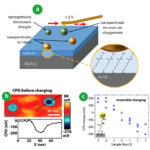When gold nanoparticles turn into nano-memories…
 A gold nanoparticle can be viewed as an infinitesimal point of contact that helps understanding how electrical currents behave at the nanoscale. When this nanoparticle is anchored to a surface, it behaves like a conductor, allowing electrons to go through. However, by attaching it via selected molecules, nanoparticles can retain electrical charges and turn into memories about ten nanometres in diameter. A member of INSP, in collaboration with American and Spanish researchers, revealed this mechanism with the tip of a Kelvin Probe Force Microscope (KPFM).
A gold nanoparticle can be viewed as an infinitesimal point of contact that helps understanding how electrical currents behave at the nanoscale. When this nanoparticle is anchored to a surface, it behaves like a conductor, allowing electrons to go through. However, by attaching it via selected molecules, nanoparticles can retain electrical charges and turn into memories about ten nanometres in diameter. A member of INSP, in collaboration with American and Spanish researchers, revealed this mechanism with the tip of a Kelvin Probe Force Microscope (KPFM).
Caption: (a) Scheme of a G.O.M. (Grafted Organic Monolayer) surface on silicon and four gold nanoparticles. With the tip of a Kelvin Probe Force Microscope (KPFM) these nanoparticles can be charged and demonstrate a memory effect: the electrical charge remains at least 24 hours. (b) KPFM measurement of the surface contact potential (CPD) generated by a nanoparticle at rest. (c) Summary of CPD measurements for different charged states of nanoparticles.
Reference
« Nanoimaging of Organic Charge Retention Effects : Implications for Nonvolatile Memory, Neuromorphic Computing, and High Dielectric Breakdown Devices » Zhang, Y. ; Kang, J. ; Pluchery, O. ; Caillard, L. ; Chabal, Y. J. ; Wang, L.-W. ; Sanz, J. F. ; Salmeron, M. ACS Applied Nano Materials 2019, 2 (8), 4711-4716

